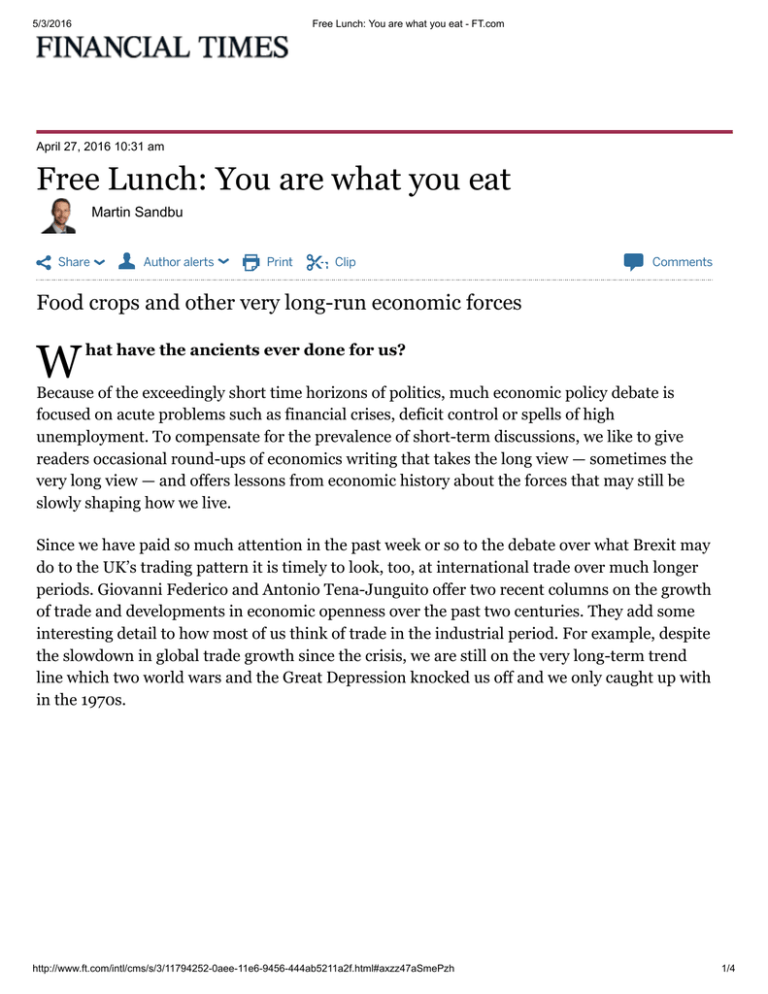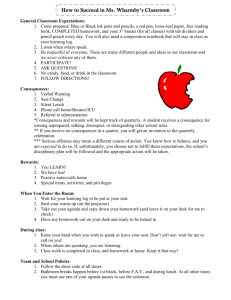W Free Lunch: You are what you eat
advertisement

5/3/2016 Free Lunch: You are what you eat ­ FT.com April 27, 2016 10:31 am Free Lunch: You are what you eat Martin Sandbu Share Author alerts Print Clip Comments Food crops and other very long­run economic forces W hat have the ancients ever done for us? Because of the exceedingly short time horizons of politics, much economic policy debate is focused on acute problems such as financial crises, deficit control or spells of high unemployment. To compensate for the prevalence of short­term discussions, we like to give readers occasional round­ups of economics writing that takes the long view — sometimes the very long view — and offers lessons from economic history about the forces that may still be slowly shaping how we live. Since we have paid so much attention in the past week or so to the debate over what Brexit may do to the UK’s trading pattern it is timely to look, too, at international trade over much longer periods. Giovanni Federico and Antonio Tena­Junguito offer two recent columns on the growth of trade and developments in economic openness over the past two centuries. They add some interesting detail to how most of us think of trade in the industrial period. For example, despite the slowdown in global trade growth since the crisis, we are still on the very long­term trend line which two world wars and the Great Depression knocked us off and we only caught up with in the 1970s. http://www.ft.com/intl/cms/s/3/11794252­0aee­11e6­9456­444ab5211a2f.html#axzz47aSmePzh 1/4 5/3/2016 Free Lunch: You are what you eat ­ FT.com The 1970s was also a period when economic openness, as measured by the global trade­to­GDP ratio regained the intensity from the eve of the first world war, which John Maynard Keynes so elegiacally described in the Economic Consequences of the Peace. But we should treat this measure of openness with some caution. First, because Federico and Tena­Junguito point out that it gives a lot of weight to economically advanced countries — weighing by population shows a slower rebound in openness. Second, because the trade­to­GDP ratio is itself probably an underestimate of trade’s importance to the economy, as we explained on Monday. And third, because historical GDP data are more suspect the further back they go. Emanuele Felice reviews the latest update of the Maddison Project (hat tip: Brad DeLong), the extraordinarily ambitious research project to establish historical GDP statistics. This, as Felice points out, is very hard to do, and we should treat the numbers with caution. Some will be speculative. “Speculative”, however, need not be a pejorative term for attempts to understand ancient history, its economic mechanisms and how they still affect us today. Speculation can give rise to measurable theoretical predictions. Among the most fascinating are the arguments about the mechanisms by which geography may shape social institutions which in turn affect economic and political development for centuries if not millennia to follow. Joram Mayshar, Omer Moav and Zvika Neeman have a series of thought­provoking papers in this vein. In one, they attribute the distribution of power and property rights in early societies to how difficult or easy geography makes it for rulers to monitor agricultural output. In another, written with Luigi Pascali, they hypothesise — and find evidence — for the surprising importance of the type of http://www.ft.com/intl/cms/s/3/11794252­0aee­11e6­9456­444ab5211a2f.html#axzz47aSmePzh 2/4 5/3/2016 Free Lunch: You are what you eat ­ FT.com food crop. The paper is engagingly written up and put in context of the broader literature by the Washington Post: the main idea is that the development of hierarchical institutions depends on the relative productivity of grains that are harvested once a year and have to be stored, over root crops such as potatoes or manioc that are hard to store and can be harvested year­round. “Cereals, for which storage is feasible and required, are easier to confiscate than roots and tubers, for which post­harvest storage is typically inefficient and unnecessary. Thus, regional differences in the suitability of land for the cultivation of roots and tubers or of cereals can cause differences in the formation of hierarchy and in social institutions.” It seems that as societies, not just as individuals, we are what we eat. Other readables Bank Underground, the Bank of England’s subversive blog, outdoes itself by challenging the assumption that people prefer more consumption to less. The New York Times tells the story of how Argentina settled its debt with holdout investors. A conversation with David Card and Alan Kruger, the economists who turned the conventional wisdom on minimum wages upside down. Numbers news The employment rate for EU residents between 20 and 64 years of age is now 70.1 per cent, within a whisker of the pre­crisis peak of 70.3 per cent. The female employment rate is the highest on record. To receive Martin Sandbu’s Free Lunch by email every workday, sign up here. Share Author alerts Man or machine? Building robots like us Print Clip FirstFT ­ Nanobot engine developed, Leicester’s 5,000­1 title win Comments Market Minute ‑ glittering gold, surging yen Printed from: http://www.ft.com/cms/s/3/11794252­0aee­11e6­9456­444ab5211a2f.html Print a single copy of this article for personal use. Contact us if you wish to print more to distribute to others. http://www.ft.com/intl/cms/s/3/11794252­0aee­11e6­9456­444ab5211a2f.html#axzz47aSmePzh 3/4 5/3/2016 Free Lunch: You are what you eat ­ FT.com © THE FINANCIAL TIMES LTD 2016 FT and ‘Financial Times’ are trademarks of The Financial Times Ltd. http://www.ft.com/intl/cms/s/3/11794252­0aee­11e6­9456­444ab5211a2f.html#axzz47aSmePzh 4/4


